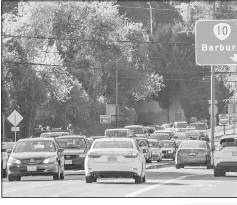SW Corridor MAX costs still a question mark
Estimate doesn’t include everything outlined in project
By JIM REDDEN
The Tribune
The proposed Southwest
Corridor MAX line is already estimated to be the most expensive transit project ever
considered in the region. But the current estimate does not include everything related to it, and those additional costs are not yet fully projected.
The line is being planned by Metro, the elected regional government, from Portland to Tualatin through Tigard. The City Council is scheduled to consider the recommended route from downtown along Southwest Barbur Boulevard to the Tigard city limits on Nov. 1.
The project is currently estimated at $2.64 billion to $2.86 billion in 2024 dollars, the estimated midpoint of its construction. After adjusting for inflation, that is already more than the $1.49 billion spent on TriMet’s Orange Line between Portland and Milwaukie, the most expensive transit project so far.
But planning-related documents identify a number of directly related projects that will push the total costs much higher. They include:
■ Reconfiguring what is called the Ross Island Bridgehead. It includes the ramps at the west end of the Ross Island Bridge, such as the current alignments to Southwest Naito Parkway, and other streets in the area functioning as regional transportation connections.
According to a TriMet planning document, work would include converting Naito to a surface boulevard with at-grade intersections. Nearly three acres of land would be made available for development. It could support up to 400 homes.
The preliminary estimate for such work is $80 million. Portland, Metro, TriMet and the Oregon Department of Transportation are drafting a Memorandum of Understanding for the project, which will begin with a design, cost estimates and a funding strategy.
■ Realigning streets in the West Portland Town Center, which is also known as the Crossroads area because of the complex intersection of Southwest Barbur Boulevard and Southwest Capitol Highway over I-5.
Although the MAX line will cross I-5 there as well, the final alignment there is still in play, including the future of the existing Barbur Transit Center park and ride lot, and the nearby intersection of Barbur and Southwest Taylors Ferry Road. The Portland Bureau of Planning and Sustainability is studying redevelopment opportunities in the area. There is no cost estimate.
■ Replacing the Vermont and Newberry viaducts that support Barbur between Southwest Hamilton Street and Southwest Brier Place.
Although the MAX line is planned to run down the middle of Barbur, these aging wooden structures are not earthquake proof. In addition, the section of Barbur they support is not wide enough for the sidewalks and bike paths called for in the project. The TriMet planning document says Portland and ODOT should seek funding for replacing the viaducts that will not be considered part of the project. There is no cost estimate.
Many other transportationrelated projects are already proposed in the corridor that are related. They include roadway, sidewalk and bike path connections to the MAX stations along it. A list of dozens of such projects prepared by Metro in 2016 totaled more than $205 million in 2014 dollars.
The list was compiled from transportation and transit plans previously adopted by some of the project partners, including Portland, Tigard and Tualatin. Still more projects without specific cost estimates are included in a Southwest Corridor Shared Investment Strategy adopted by all project partners in 2016.
But that strategy did not include the affordable housing projects called for in the Southwest Corridor Equitable Housing Strategy adopted by the council on Oct. 4. It says $1.5 billion should be spent on affordable housing and rental services over the next 10 years to help lower income households in the corridor.
It is unclear how all of these projects will be paid for, although several potential partial funding sources are available or being considered.
For example, Portland voters approved a $258 million affordable housing bond at the November 2016 election. Metro also has placed a $653 million regional affordable housing bond on the Nov. 6 general election ballot. Metro has promised to place a regional transportation funding measure on the November 2020 ballot to help finance the MAX line that could help pay for some related projects.
